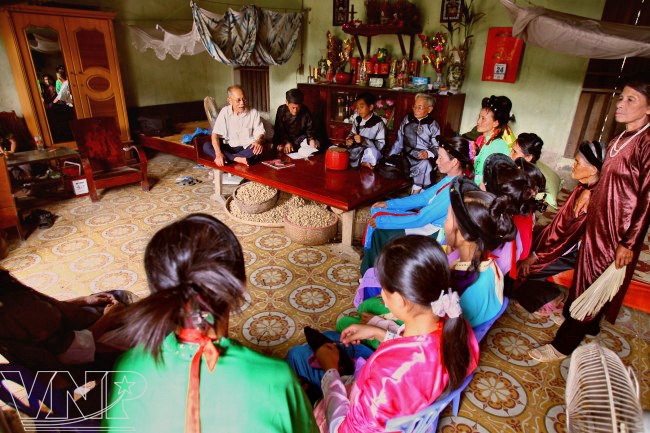On November 24, 2011, at the 6th meeting of UNESCO Intergovernmental Committee for the Safeguarding of Intangible Cultural Heritage in Bali, Indonesia, the dossier of Xoan singing in Phu Tho Province, Vietnam was officially recognized as an Intangible Cultural Heritage in need of urgent protection by UNESCO.
This is not only the happiness of the people in Phu Tho Province but also the pride of Vietnamese people.

Xoan singing artisans in Phu Tho Province. Photo: Tran Thanh Giang

Xoan singing at the communal house. Photo: VNP

The delegation of UNESCO Committee studies Xoan singing art in Phu Tho Province. Photo: Tran Thanh Giang

“Hat mo ca” is a melody that shows the desire for growing of Xoan singing. Photo: Tran Thanh Giang

The delegation of the Vietnam National UNESCO Committee exchanges with Xoan singing performers.
Photo: Tran Thanh Giang

Foreign tourists share their feeling about Xoan singing. Photo: Tran Thanh Giang

Old artisans of Phu Tho Xoan singing group at the exchange with the delegation of UNESCO Committee.
Photo: Tran Thanh Giang |
According to the researchers, Xoan singing is ceremonial folk singing, performed with the intention of worshipping the village’s tutelary. It is related to the harvest festival of the local people. In relation to the old custom, when spring comes, Xoan singing groups in Phu Tho often have a Xoan performance at the village’s communal house or shrine and a Hung Kings’ Temple on January 5 of the lunar year (on Tet Holiday). The origin of Xoan singing is attached to legends during the Hung King Dynasty (over 2,000 years BC). The original Xoan singing groups mostly came from villages in the central area of Van Lang nation (present-day Viet Tri City – Phu Tho Province). Therefore, Xoan singing includes many ancient cultural features of the first period of the founding of the nation.

The traditional costume of Xoan singing female performers.
Photo: Tran Thanh Giang |

A scene in the “Trong quan Duc Bac” dancing-singing performance. Photo: Tran Thanh Giang |

A melody of Xoan singing.
Photo: Tran Thanh Giang |

Girls in Xoan singing groups look graceful in performing “Moi ruou”, beginning each Xoan singing performance.
Photo: Tran Thanh Giang |
The profile of Xoan singing of Vietnam is highly appreciated by UNESCO because it meets important demands and criteria, such as cultural value, sense of community in creativeness and the handing down from generation to generation. It is the strong vitality of this artistic medium and the pledge of the people and the authorities that will help preserve it in the future.

After thousands of years, Xoan singing in Phu Tho Province still has a strong vitality as it is handed down from generation to generation. Photo: VNP

Xoan singing becomes an indispensable part of the cultural life of people in the midland Phu Tho. Photo: VNP

Generations in a Xoan singing group in Phu Tho. Photo: VNP
|
So far, Vietnam has 16 heritages recognized by UNESCO.
|
Vietnam’ heritages recognized by UNESCO
1. The Complex of Monuments of the imperial capital of Hue (1993)
2. Ha Long Bay (1994 and 2000).
3. Hoi An Ancient Town (1999)
4. My Son Sanctuary ( 1999)
5. Hue Nha Nhac (Royal Court Music) ( 2003)
6. Phong Nha-Ke Bang National Park( 2003)
7. The Cultural Space of Tay Nguyen Gongs ( 2005)
8. Ca Tru (Ceremonial singing) ( 2009)
9. Bac Ninh Quan Ho (Love duets singing) ( 2009)
10. Nguyen Dynasty Wood-Blocks (2009)
11. The central section of the Imperial Capital of Thang Long ( 2010)
12. Dong Van Rocky Plateau (2010)
13. Giong Festival in Phu Dong and Soc Temple (2010)
14. 82 Doctorial Steles in Van Mieu-Hanoi(2010)
15. Ho Dynasty Citadel ( 2011)
16. Xoan singing in Phu Tho (2011)
|
Story: Ngan Ha - Photo: Thanh Giang – VNP
Story: Ngan Ha - Photo: Thanh Giang – VNP